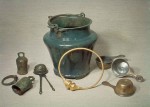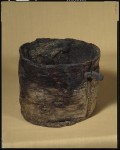 A new study on residue found in Scandinavian artifacts from 1500 B.C. to the first century A.D. has revealed that the wide variety of ingredients used to make Nordic grog ranged from local fruits, grains, herbs and spices to grape wine imported from southern or central Europe. The ancient sources on the grog question are all Greek and Roman, written a thousand plus years after the earliest archaeological evidence. They aren’t exactly objective either, clearly disdaining the barbarous northern rustics and their uncouth alcoholic beverages. First century B.C. Greek historian Dionysius of Halicarnassus said the Celtic fermented brew was made out of “barley rotted in water.” His contemporary Diodorus Siculus said they strained their thick drinks through their mustaches.
A new study on residue found in Scandinavian artifacts from 1500 B.C. to the first century A.D. has revealed that the wide variety of ingredients used to make Nordic grog ranged from local fruits, grains, herbs and spices to grape wine imported from southern or central Europe. The ancient sources on the grog question are all Greek and Roman, written a thousand plus years after the earliest archaeological evidence. They aren’t exactly objective either, clearly disdaining the barbarous northern rustics and their uncouth alcoholic beverages. First century B.C. Greek historian Dionysius of Halicarnassus said the Celtic fermented brew was made out of “barley rotted in water.” His contemporary Diodorus Siculus said they strained their thick drinks through their mustaches.
These descriptions are less than useful from an archaeological perspective. They are aren’t geographically specific beyond referring to peoples north of the Alps and don’t delve into the details of the ingredients. To find out what Bronze and Iron Age Nordic grog was made of, therefore, researchers turned to artifacts discovered in burials and hoards from Denmark and Sweden.
![]() Four archaeological samples were chosen. The oldest is a jar buried with a warrior in a tumulus in Nandrup, Jutland, northwest Denmark, that dates to Period II of the Nordic Bronze Age (ca. 1500–1300 B.C.). The second is a strainer found in a hoard in Kostræde, southwest of Copenhagen, which dates to the Late Bronze Age (ca. 1100–500 B.C.). The third sample came from a large bronze bucket (situla in Latin) found in the grave of a high-status woman in Juellinge, on the island of Lolland, southeast Denmark. It dates to the Early Roman Iron Age (ca. 200 B.C.). The last artifact tested in the study is a long-handled strainer-cup from a bronze wine-set from the Early Roman Iron Age (first century A.D.) that was buried next to a ring fort in Havor on the Swedish island of Gotland.
Four archaeological samples were chosen. The oldest is a jar buried with a warrior in a tumulus in Nandrup, Jutland, northwest Denmark, that dates to Period II of the Nordic Bronze Age (ca. 1500–1300 B.C.). The second is a strainer found in a hoard in Kostræde, southwest of Copenhagen, which dates to the Late Bronze Age (ca. 1100–500 B.C.). The third sample came from a large bronze bucket (situla in Latin) found in the grave of a high-status woman in Juellinge, on the island of Lolland, southeast Denmark. It dates to the Early Roman Iron Age (ca. 200 B.C.). The last artifact tested in the study is a long-handled strainer-cup from a bronze wine-set from the Early Roman Iron Age (first century A.D.) that was buried next to a ring fort in Havor on the Swedish island of Gotland.
All four of the artifacts have ancient residue still attached in sufficient quantities to be tested for their composition. Researchers used a combination of analytic techniques including microscopic examination, infrared spectrometry and gas chromatography-mass spectrometry.
In the Nandrup jar, the residue was entirely composed by pollens — lime tree, meadowsweet and white clover — indicating the presence of a honey product. It wasn’t just honey, though. The residue is from an evaporated liquid and given the lack of any other elements in the residue, researchers believe the vessel contained unadulterated mead.
 Honey was a rare and expensive commodity in the days before hive cultivation. Pure mead was reserved only for the elite, although the more ingredient-rich hybrid drinks could also be high status. The incredibly well-preserved grave of a young woman, a priestess or ritual dancer, from the same era found at Egtved in Jutland contained a birch bucket with residue of bog cranberries, cowberries, wheat grains, bog myrtle filaments, lime tree pollen, meadowsweet, and white clover. So it seems she was buried with the same mead the warrior had in his grave, but with the addition of barley beer and fruit elements.
Honey was a rare and expensive commodity in the days before hive cultivation. Pure mead was reserved only for the elite, although the more ingredient-rich hybrid drinks could also be high status. The incredibly well-preserved grave of a young woman, a priestess or ritual dancer, from the same era found at Egtved in Jutland contained a birch bucket with residue of bog cranberries, cowberries, wheat grains, bog myrtle filaments, lime tree pollen, meadowsweet, and white clover. So it seems she was buried with the same mead the warrior had in his grave, but with the addition of barley beer and fruit elements.
The Kostræde sample returned birch tree resin, beeswax, pine resin, azelaic acid (probably a derivative of oleic acid, found in a variety of plants, but could also come from grains like wheat, rye, and barley), juniper, herb bog myrtle, grape wine and eucalyptol, a compound found in mugwort, cranberry and rosemary. In the Juellinge residue, testing discovered the remains of barley, bog cranberry, lingonberry, juniper, herb yarrow, grape wine, bog myrtle and yeast. The Havor sample was found to contain birch tree resin, plant products, grape wine and eucalyptol.
 This is the first chemical proof of the use of bog myrtle, yarrow, juniper, birch tree resin and grape wine in Nordic grog. It testifies to the hybrid nature of fermented beverages in Bronze and Iron Age Scandinavia, how diverse the ingredients were. The discovery of the wine elements is particularly significant.
This is the first chemical proof of the use of bog myrtle, yarrow, juniper, birch tree resin and grape wine in Nordic grog. It testifies to the hybrid nature of fermented beverages in Bronze and Iron Age Scandinavia, how diverse the ingredients were. The discovery of the wine elements is particularly significant.
It demonstrates the social and ceremonial prestige attached to wine, especially when it was served up as ‘Nordic grog’ in special wine-sets imported from the south. It also points to an active trading network across Europe as early as the Bronze Age in which amber might have been the principle good exchanged for wine. The presence of pine resin in the beverages likely derives from the imported wine, added as a preservative for its long journey northward.
Did they also have a look at the splendid ‘Hoby silver beaker’, which was also found on the island of Lolland ?
In contrast to, by modern standards, ‘barbaric’ roman wine recipes, ‘rotten barley water’ was seemingly not a big hit in the south.
They did not. Or at least, if they did look at it, they did not take samples from it.
Since learning that I have more Nordic/Celtic ancestry than I thought, I have become more interested in the history. The info about the beverages was interesting, but I have to confess that the utensils themselves were more fascinating to me (I would love some like those in my kitchen). But most of all, I yearned to go really close in on the woven goods in the Egtved burial and study them. Beautiful. Off to do some searching…
The degree of preservation of organic materials in the Egtved burial is truly exceptional. This is why I heart bogs so much. I’m totally obsessed with the string skirt and the wool belt with the fabulously large disc centerpiece.
I believe that you have misused the word “grog.” Grog is diluted rum name after the 17th century Admiral Edward Vernon who was nicknamed “Old Grog” because of his habit of wearing a grogham cloth cloak.
You may have confused this with the Scandinavian alcoholic beverage “glogg” (umlaut over the o).
I can’t think of a generic word for the type of beverages evidenced by the analysis.
Also, I suspect that some of the ingredients may have been added for ceremonial/religious reasons rather than for pleasant flavor.
The study authors used the term “grog” or “Nordic grog,” presumably to differentiate it from its British naval homonym.
Then my comment should have been directed to them. I believe that using “grog” as a term for any alcoholic drink is an Australian and NZ usage. Maybe one of the study authors has down under background.
I remain a historical purist and associate grog with wooden ships and iron men.
I my be misremembering but Admiral Vernon may have been the first to add lime juice to the diluted rum.
Keep up the good work. You have given us much pleasure.